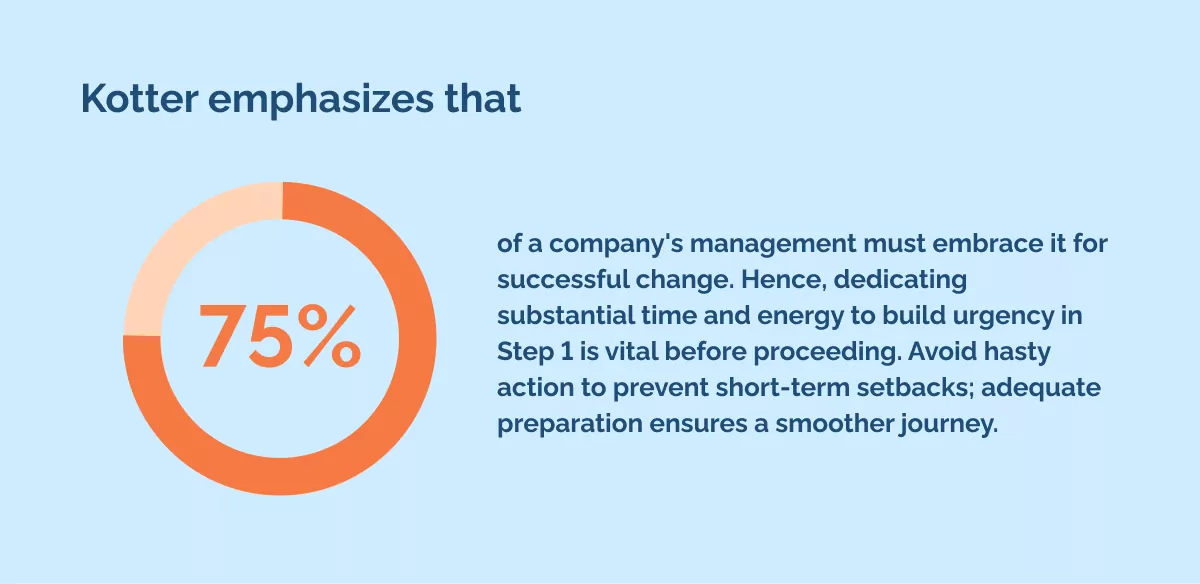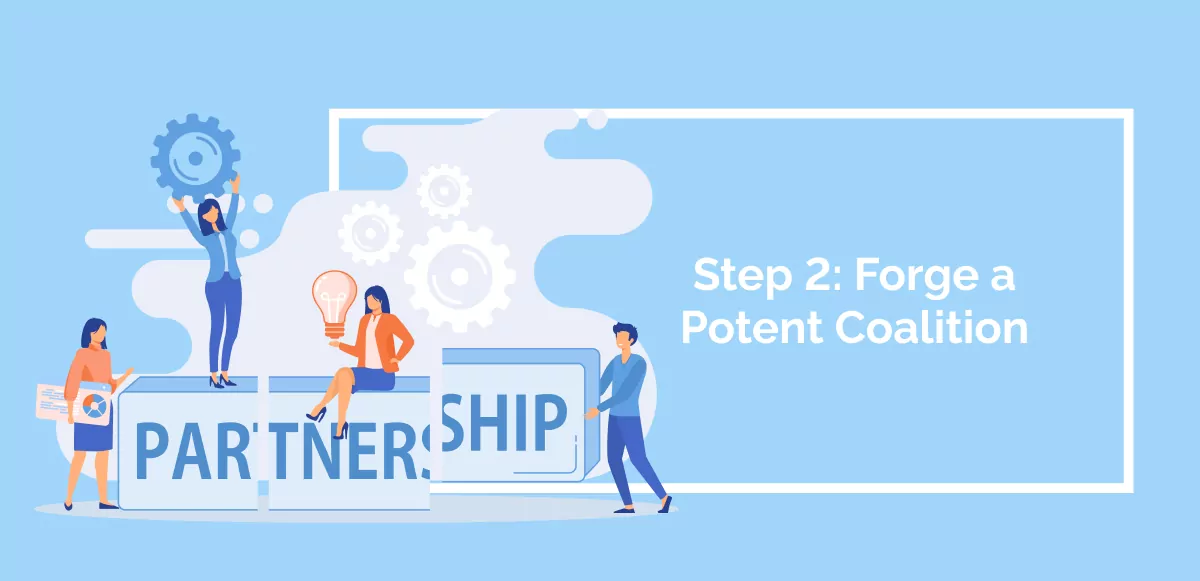
You’re deep into your change initiative, but something’s wrong.
Employees aren’t engaging with the changes as planned and revert to their previous approaches to their workflow.
What should you be doing differently in your change management approach? At this point, it is essential to consider change models like Kotter’s eight-step model to support staff to accept changes.
Change models shook the foundations of the business world when they were first published. But it’s essential to ensure they remain relevant and review their problems and benefits.
Kotter’s eight-step change model is one of the two most popular change management models, but what are its problems and benefits in 2023, and is it still relevant?
Only 34% of change initiatives succeed, and two-thirds of employees suffer burnout, causing digital transformation delays, making models like Kotter’s 8-step model the key to change success.
To help you understand Kotter’s eight-step change model and its problems and benefits, we will explore the following topics:
- What Is Kotter’s 8-Step Change Model?
- How is Kotter’s 8-step change model relevant in 2023?
- The 8 steps of Kotter’s change model and how to use them
What Is Kotter’s 8-Step Change Model?
Explaining Kotter’s 8 Step Change Model 240p
Kotter’s widely recognized 8-Step Change Model enables organizations to address shifts in their structure and embrace digital advancements.
It mobilizes employees to swiftly incorporate new procedures, technology, and other organizational shifts. It creates urgency with a clear and appealing vision via short-term wins to implement change effectively.
Initially presented in his book, “Leading Change,” Harvard Business School professor Kotter revised it to suit evolving business needs and expedite digital transformation and change adoption in enterprises.
How is Kotter’s 8-step change model relevant in 2023?
In 2023, Kotter’s 8-step change model remains profoundly relevant, showcasing its enduring adaptability in the face of evolving challenges.
With the advent of the COVID-19 pandemic, organizations worldwide experienced unprecedented disruptions, compelling them to adapt and innovate rapidly.
Kotter’s model provides a structured framework for navigating such crises, offering guidance on mobilizing employees and implementing change effectively, increasing employee retention and digital resilience.
Furthermore, in the context of generative AI and technology like ChatGPT, Kotter’s change management model aids in integrating cutting-edge tools seamlessly.
As the business landscape transforms, Kotter’s model is a timeless resource, enabling organizations to thrive in an ever-changing world.
The 8 steps of Kotter’s change model and how to use them
Let’s examine each step of Kotter’s eight-step change model, with a guide on using each one successfully for optimized organizational processes.
Step 1: Create a Sense of Urgency
It’s advantageous if the entire company is genuinely enthusiastic about it to facilitate change.
Establish urgency surrounding the need for change, igniting the initial motivation for progress.
This step goes beyond presenting lackluster sales statistics or discussing heightened competition.
Engage in an open, persuasive dialogue about market dynamics and competition. When numerous people begin discussing the proposed change, urgency naturally intensifies.
How to use this step:
- Identify potential threats and develop future scenarios.
- Explore exploitable opportunities.
- Initiate candid discussions with compelling reasons to stimulate conversations.
- Seek support from customers, external stakeholders, and industry experts.
Also consider:
Kotter emphasizes that 75% of a company’s management must embrace it for successful change. Hence, dedicating substantial time and energy to build urgency in Step 1 is vital before proceeding. Avoid hasty action to prevent short-term setbacks; adequate preparation ensures a smoother journey.
Step 2: Forge a Potent Coalition
Convince individuals of the change’s necessity, often necessitating robust leadership and visible backing from influential figures within the organization.
Mere management won’t suffice; leadership is paramount.
Effective change leadership can emerge from various organizational tiers, not solely following traditional hierarchies.
Form a coalition comprising influential figures with diverse power sources, such as job titles, expertise, and political significance.
Once established, this “change coalition” should function cohesively, continually bolstering urgency and momentum for change.
How to use this step:
- Identify authentic leaders and key stakeholders.
- Solicit emotional commitment from these influential figures.
- Foster team cohesion within the change coalition.
- Evaluate for weaknesses, ensuring diversity in departmental representation and organizational levels.
Step 3: Craft a Vision for Change

At the outset of contemplating change, numerous innovative ideas and solutions abound. Link these concepts to a comprehensible, memorable, overarching strategic vision.
A clear vision aids comprehension, making it easier for individuals to understand the purpose behind their actions. When people grasp the intended achievement, directives become more logical.
How to use this step:
- Identify core values central to the change.
- Develop a concise summary of the envisioned future.
- Create an execution strategy.
- Ensure the change coalition can articulate the vision concisely.
- Practice delivering the vision speech regularly.
Step 4: Share the Vision
The success of your vision hinges on how you communicate and integrate it into every aspect of operations. Frequent, impactful communication and alignment with daily activities are crucial.
Don’t limit vision communication to special meetings; infuse it into everyday discussions. Utilize the vision as a guiding principle for decision-making and problem-solving. Demonstrating the desired behavior is more compelling than words alone.
How to use this step:
- Regularly discuss the change vision.
- Address concerns openly and honestly.
- Apply the vision across all operational facets.
- Lead by example.
Step 5: Eliminate Obstacles
By following the previous steps and reaching this stage, you’ve cultivated buy-in and enthusiasm throughout the organization. However, some resistance may persist, and structural impediments could hinder progress.
Establish mechanisms for change and continually identify barriers. Removing obstacles empowers individuals to execute the vision and propel change.
How to use this step:
- Identify or appoint change leaders responsible for implementation.
- Assess organizational structures, job descriptions, and performance systems for alignment with the vision.
- Reward change catalysts.
- Assist those resisting change in understanding its necessity.
- Swiftly eliminate barriers, whether human or procedural.
Step 6: Achieve Short-Term Victories
Success serves as a powerful motivator. Provide early victories in the change process, allowing your team to experience tangible progress quickly. Set short-term, achievable targets to maintain motivation and deter negative attitudes.
How to use this step:
- Select projects that can be implemented without significant resistance.
- Opt for cost-effective early targets.
- Carefully evaluate potential benefits and drawbacks.
- Reward contributors to target achievement.
Step 7: Build on Progress
Kotter contends that declaring victory prematurely often leads to change project failures. Genuine change requires continuous development. Quick wins mark the beginning of a comprehensive journey.
Each success presents opportunities for improvement and expansion.
How to use this step:
- Analyze successes and areas for improvement.
- Set goals to sustain momentum.
- Explore continuous improvement concepts, like kaizen.
- Refresh ideas by introducing new change agents and leaders.
Step 8: Embed Changes in Corporate Culture
To ensure enduring change, integrate it into the organization’s core. Corporate culture influences action, so align your vision’s values with day-to-day work to make change stick.
Consistently reaffirm the change’s presence across all aspects of the organizational culture.
Additionally, successfully implement change by providing ongoing support from current and incoming company leaders.
How to use this step:
- Regularly discuss progress.
- Incorporate change ideals in hiring and training.
- Publicly acknowledge contributions of the original change coalition.
- Plan for leadership transitions to preserve the change legacy.
Prioritize staff when using Kotter’s 8-step change model
In employing Kotter’s 8-step change model, prioritizing your staff remains paramount when you prioritize it over other change management models.
This comprehensive approach recognizes that change is not just about processes and procedures but the people who drive it.
Implementing organizational change successfully involves cultivating urgency, building strong coalitions, and fostering a culture of transparency and support.
Keeping employees at the forefront ensures their commitment, which, in turn, is pivotal for any organization’s sustained growth and adaptability, helping you create success stories for years to come.
People also ask
How does Kotter generate short term wins?
Kotter’s 8-step change model emphasizes the importance of creating short-term wins to build momentum and support for the overall change initiative.
Generating short-term wins involves the following key strategies:
- Identify Quick Wins.
- Communicate Success.
- Reward and Recognize.
- Use Wins Strategically.
- Learn and Adapt.
What is Kotter’s integrative model?
Kotter’s integrative model is like looking at a giant puzzle. He uses this model to see how all the pieces fit together and how they can make an organization work more efficiently.
It’s like when an architect uses building blocks to figure out how to build a new structure by ensuring all the blocks fit together before the building begins.
What are the criticisms of Kotter’s model?
Some of the criticisms of Kotter’s eight-step change model include:
- It emphasizes making people feel the need for change but doesn’t give many specific instructions.
- It follows a step-by-step order, which can take long to finish.
Consider these criticisms before choosing Kotter’s eight-step change model in 2023.
Tristan Ovington
Tristan Ovington is a professional senior writer and journalist, specializing in providing expert insights on various topics such as digital adoption, digital transformation, change management, and Cloud apps. He delivers his knowledge through accessible online content that is data-driven and presented in a friendly tone, making it easy for readers to understand and implement.











